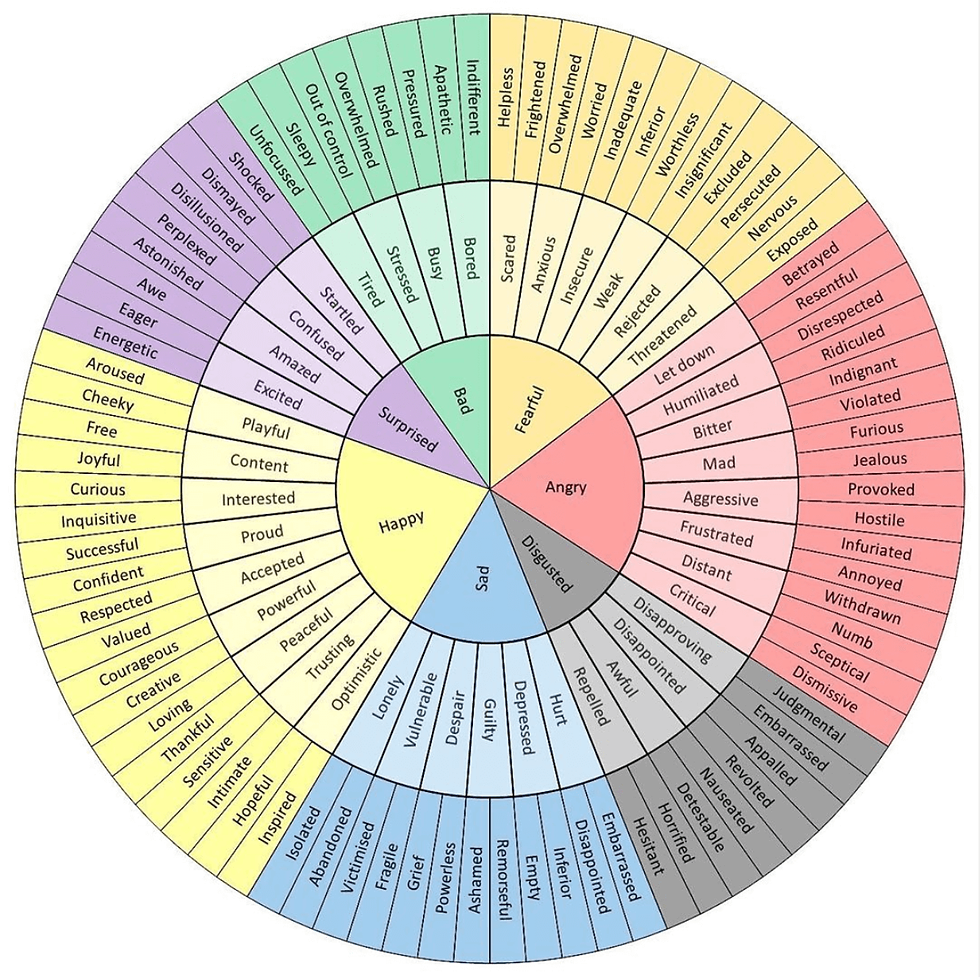‘Embracing Your Emotions’: The Importance of Understanding How You Feel
- Jhanvi Mehta

- May 16, 2023
- 3 min read

Our emotions drive us to think, feel and act a certain way as we navigate ourselves through most life situations.
The American Psychological Association (APA) defines emotion as a complex reaction pattern involving experiential, behavioural and physiological elements.
Emotions can be complex and varied. Some emotions we like to feel more than others. Happiness over sadness, calm over anger and so on. Thus, we often label these as ‘good’ and ‘bad’ feelings or emotions. But what we often fail to understand when trying to escape or avoid these ‘negative’ emotions is that all of our emotions, 'good 'and ‘bad’, serve a valuable purpose in our lives.
Fear, for example, serves the functional purpose of alerting us in the event of a perceivable threat or danger. This allows for faster reaction times in response to any emergencies. Stress has the function of survival and works positively to motivate us to make necessary changes, also termed eustress. However, the times when we experience these emotions negatively are when they are chronic and present in the absence of any foreseeable danger or need for survival. Thus, understanding the root of our emotions is key to acknowledging why we feel the way we feel. This makes the goal of making necessary changes in our behaviours and actions and rectifying any problematic situation that may arise a lot simpler.
While the goal may sound easy, the journey to get there is not always uncomplicated. On occasion, we may not truly understand which emotion we are experiencing. This leads to several futile attempts in trying to solve our problems, which are often unsuccessful and frustrating to endure. The key to understanding the extent of our emotions is to navigate the reasons or themes for feeling a particular emotion. The majority of the common emotions have a recurring theme that helps us identify which emotions we are feeling in the first place.
Here is a checklist of a majority of the perceived negative emotions we may feel on a daily basis.
Emotion | Theme | Example |
Anger | Rule Transgression: By Others or Self | When someone does not follow/behave in the manner that you told them to. |
Guilt | Breaking Own Morals | When you break your own moral code. |
Shame | Scrutiny/Being Judged | When you feel that someone may judge you (for your behaviour, clothing, etc.) |
Anxiety | Negative Anticipation/Perceived Fear/Exaggerated Negative Outcomes | When you perceive a situation as a potential disaster, even though it may not be one or is just a minor issue. |
Depression | Hopelessness | When you feel that the future is hopeless and feel self-directed anger upon this feeling hopeless/helpless. |
Jealousy | Possessiveness: In Intimate Relations | When you feel strong emotions for another person with intentions of possessing them/having control over them. |
Envy | Materialistic Objects: Power, Fame, Authority | When you wish to have certain objects that others do, but you don’t. |
Hurt | Breaking of Expectations/Unfulfilled Expectations | When someone/something does not live up to your expectations of them. |
With this list, you can identify what theme is prevalent in the problem arising in front of you and, thus, navigate your emotions with relative ease. Once we are able to identify the larger emotion, we can then move on to problem-solving.
In certain cases, however, our emotions, as mentioned before, can be quite complex. We may need clarification with words that are synonymous with one another or have a much broader meaning. For example, when we say we feel sad, it can mean that we are sad because we are hurt or guilty of something or even because we are experiencing grief. The term ‘sad’ can give us a basic understanding of the experience, but what we really feel can be further reflected upon for more insight into our emotions.
Using an Emotion Wheel in such cases is often helpful. It may open us up to several possibilities and allow us to pinpoint the exact emotion felt at that moment.

As we can see above, anger, too, can have several underlying emotions, and the onus lies upon us to sit with our feelings and identify the exact emotion experienced by us to approach the problem in front of us with clarity.
Our emotions are what make us human. We feel joy when happy about a certain outcome, sadness over losing a loved one, anxiety about a new job and so on. Emotions may also sometimes frustrate us, make us feel stuck or even feel hopeless. The list may be endless, but it is what drives us social beings to interact with one another, communicate our feelings and, in turn, form better relationships with others. No matter the situation, being aware of our own emotions and reflecting on our feelings can make us better communicators, better problem solvers and, most important of all, better people.
Please leave your feedback for this blog post here.
References
American Psychological Association. Emotion, APA Dictionary of Psychology, Website.




Comments